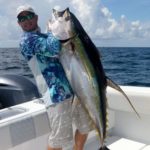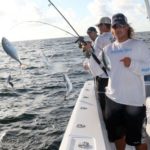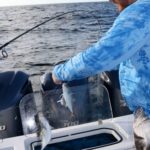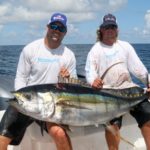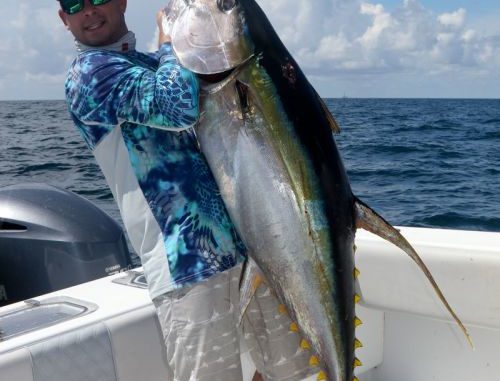
Yellowfin test tackle and resolve — but are worth it
When Brian Evans left Cajun Fishing Adventures in Buras around 6:30 a.m., he knew he’d spend about 10 hours in the Gulf of Mexico. He probably didn’t expect to spend 15 percent of that time fighting a single yellowfin tuna — one that went 110 pounds.
Yellowfin are shaped like footballs, marked with distinctive lemon finlets and have long dorsal and anal fins resembling sickles, They are the premier target for the offshore boats from Port Fourchon to the Delta’s southernmost city. With Capt. Wade Wells and mate Chris Fotta of Venice-based Mexican Gulf Fishing Company guiding a group our day’s mission, we’d get a good look at the performance and perseverance needed to best a beast like the one that gave Evans a memorable workout.
Fall through winter typically sees the fish moving toward land, as low river flow allows the clean Gulf water to move closer. The tradeoff, of course, are the cold fronts that drive seas to sloppy, if not unbearable levels.
Spring starts to offer more stable weather patterns, but rain and upstream snow melt sends a massive plume of brown river water into the Gulf. The tuna don’t leave, they simply push farther offshore, so time and fuel investments increase.
Summer months, while given to frequent and fierce pop-up storms, often offer relatively calm conditions and easier runs to the deep floater rigs, where strong upwellings flourish the food chain that attracts powerhouse pelagics like tuna and the frequent blue marlin thrill ride.
Experienced anglers monitor sea surface temperatures and chlorophyl charts to find where the party’s rocking the hardest. Services such as Terrafin.com, FishTrack.com, roffs.com and Hilton’s Offshore (https://www.realtime-navigator.com) offer this information.
Rockin’ the rigs
As Wells points out, tuna are highly mobile fish, so don’t be surprised to see them in open water — especially near weed lines or behind shrimp boats. Day to day, rigs represent pelagic food courts for packs of yellowfin that you’ll spot either on sonar or surface displays. Free jumpers are common, as tuna crashing surface meals blast skyward.
A great part about Delta tuna fishing is its straightforward nature. Slow trolling live mullet, menhaden, blue runners, croakers or white trout; or chunking frozen baitfish will earn you plenty of bites. Wells keeps both options on the table, but he prefers the breathers.
“It’s better to use live bait when the fish are being aggressive and you can keep them up high in the water column,” Wells said. “When you’re marking them really good, but they aren’t on the surface and not eating live bait, then it’s time to chum (and fish chunk baits).”
Keeping with his standard, Wells paired a 5 ½-foot heavy-action standup rod with a Shimano Talica 25 that carried 80-pound Seaguar braid backing, 250 feet of 80-pound monofilament topshot and an 80-pound Seaguar fluorocarbon wind-on leader snelled to a 7/0 Mustad Demon Perfect Circle — a 3X strong circle hook that stands up to big-fish pressure. Double Uni knots connected all line and leader segments.
Even when the live or cut bait’s working, Wells keeps a big popper rigged on stout spinning gear with braided main line and a fluorocarbon leader for breaking fish. Often tuna rise ahead of the boat and it’s good to get a shot at them before your bait spread reaches the fish.
Trolling live blue runners yielded several big bites; the first of which dumped one fish that simply found a way to work that big hook out of its mouth. But when the next tuna bit, Evans took his turn and got all he came for.
Fight the good fight
Simply put, when the big rod bends, this is no place to “see what ya got.” You’d better know you’re up for the challenge or this fish will embarrass you. Not frustrate, not exhaust — embarrass; as in pin you to the gunnel, make you tap out, call-your-mama -’cause-you-need-a-hug kind of shame.
The fact that he pulled a 110-pound tuna to the boat speaks volumes about Evans’ resolve, but his attention to technique was every bit as important. Trotta coached Evans on fighting the tendency to pull up too sharply, as this can break the drag’s grip and yield line. Smooth, measured strokes prove more effective at incrementally gaining ground.
Short, stout rods are helpful, but Fotta offered this warning: “You don’t want to lean out too far because that lets the tuna make a broader circle and that makes you work harder.”
With most big fish, patiently managing the initial craziness and then settling into unyielding pressure defines the general success formula.
A Luna Sea Cush-It rod butt cushion minimizes midsection bruising, but for whoppers like Evans’ fish, you’ll appreciate the superior padding and the leverage of a fighting belt, which anchors the rod butt and increases control and leverage.
Take this a step farther by adding a back brace with straps that clip to the reel. The setup not only maximizes your lean-back leverage, it increases your endurance by allowing you to rest your arms, while maintaining pressure on the fish. Evans clearly appreciated a few relaxed moments.
Also, hydration helps. Exertion taps the body’s water supply, so replenish throughout the fight. Big-fish battles are typically long and arduous, so don’t blow the game by allowing a fourth-quarter muscle cramp to stymie your execution.
Battle notes
Personal insights always help paint the sport’s true picture, so let’s hear from two who topped titan tuna that day.
“My fish had some muscle and didn’t want to come up to the surface,” Evans said. “It was fighting hard and I was pushing as hard as I could; gaining some line then losing some line. Technique-wise, it’s important to reel or gain line while the tuna is on the outer pass of the pinwheel and then reel back down when on the inside or closest side to the boat.
“Eventually, I got the fish to around 60 feet deep where I could not break the fish from doing the pinwheels. I didn’t want to give up and couldn’t give up because I knew in the back of my head this could be a yellowfin of 150-plus pounds.
“I did all I could and hung in there, eventually breaking the fish and getting him in the boat. It wasn’t as big as I thought but you never know when you will get that bite and have to fight all fish like they are your biggest yet.”
Evans’ summary: “I was spent, but it felt great having the captain haul that fish over because I knew the fight was done!”
Reid McKinstry of Mustad had his shot on the rod about an hour after Evans and, while his fish went about 30 pounds lighter, it was hardly a walk in the park. After 40 minutes of disciplined technique, McKinstry was wiping his brow and paying respect to a worthy opponent.
“I have a true love-hate relationship with yellowfin,” he said. “They are beautiful and strong and eat incredibly well, but no matter their size, there is a point in every fight where you must decide: kill or be killed!
“These fish will try and break you down. Every time I fight a yellowfin, I wish I had spent more time in the gym because their strength and speed compared to size is unmatched and they fight to the very end.”
